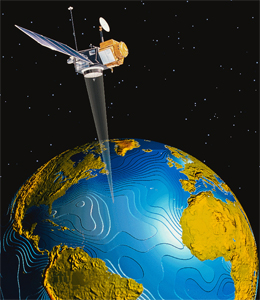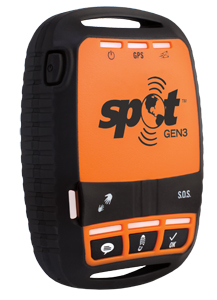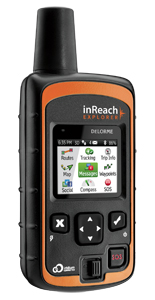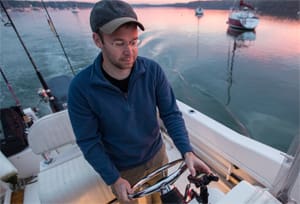When traveling, even a few miles offshore, communications start to become a bit of a challenge. Few cell signals reach much beyond 20 or so miles offshore and VHF is often not much better. So how do you stay in touch with loved ones when venturing away from civilization? Single sideband radio is still popular and useful for keeping in touch with other voyagers via HF networks (see accompanying story: “SSCA secures ‘Coast Station’ license”). However, just as sending short text messages has become wildly popular on land, texting while voyaging has its advantages as well.
One benefit of the space race has been the advent of satellite communication. Unlike land-based communication, the signals sent to satellites are not affected by geographic obstacles and are on a frequency not affected by atmospheric interference. As long as there is a satellite within a straight line of sight from your position, the signal should go through.
Groups or constellations of satellites in low Earth orbit are used to increase coverage. As one satellite gets too low in the sky to use, another will rise and become available. This means a user always has a satellite capable of receiving his signal. It also means many satellites are needed to form a network to cover the whole globe.
Unlike GPS where the satellites are launched and maintained by the government, most communication satellites are launched and maintained by the private sector. Setting up and running a satellite system is not cheap and it takes a heavy initial investment. Satellites also have limitations on the amount of data or voice calls they can handle at a single time. For this reason satellite phones tend to be a bit pricey for both voice and data streaming, which includes Internet use. Rates can run several dollars per minute, meaning long calls or casually surfing the web can be on the expensive side for most cruisers. Additionally, the equipment and contract costs for this type of communication add to the overall expense.
Lower cost option
There is, however, a cost-effective option that still allows the use of satellites for offshore communication. This option is the use of satellite text messengers and position trackers. These devices allow position reporting along with the ability to send, or to send and receive short text messages to anyone of your choosing. By sending small amounts of data in short bursts, the satellite usage and, in turn, the costs are kept to a minimum. The equipment needed to send and receive this limited amount of data is also less expensive and very portable, being not much bigger than a cellphone. These small transceivers are self-contained and do not require additional installation costs. What this means for the cruiser is that they now have an affordable and easy way to maintain basic communications with the folks back home.
Satellite position reporting has been around for a few years now, but two-way text messaging is fairly new for these devices. The first generation of position reporting was made popular and, more importantly, affordable by the SPOT transmitter. These early SPOT units were simple yet effective for providing your position and status to friends and family. They would send “breadcrumb” reports on position and speed. The “breadcrumb” means they would send an updated position report automatically every 10 minutes without the need for user input. They were also capable of sending a couple of canned messages of up to 40 characters. The user preprograms these messages ahead of time and then just presses a single button on the unit to send the message. So a quick “I’m OK” or “in port” message could be sent anytime the user wanted. They also have an emergency SOS button to send a special alert to not only the end recipient but also an emergency operator.
 |
|
Since Iridium and Orbcomm satellites are in low Earth orbit and text messages don’t need much bandwidth, texting units like the InReach and SPOT Gen3 messenger can be small. |
|
Courtesy Iridium |
As technologies have improved so have text messengers. SPOT is no longer the only game in town. DeLorme with its InReach unit jumped into the market a few years ago and has made an impressive impact. DeLorme came out with the first two-way text-messaging unit. This meant short text messages could not only be sent but received as well. SPOT soon followed with their version of a two-way unit. Other companies are also wanting to get in on this growing market. GeoPro, a Canadian company originally set up to track oil and gas workers in remote locations, is now entering the consumer adventure travel market as well.
Private satellite networks
There are two primary companies that operate satellite networks available for consumer use: Iridium and Globalstar. These two satellite systems both allow for voice and text data for the general public to use either directly or through resellers renting satellite usage. Although both offer the same basic satellite communications, there are some differences in what services are available and how they work. Before selecting a satellite text messenger it is important to know what network it uses and the advantages and disadvantages of each network.
Iridium was one of the first satellite communication companies to have a complete network up and running. Because of this, its network is a bit older — not always a good thing when it comes to technology. First placed in service in 1997, the system has been updated continuously with new satellites replacing failing ones. Along with replacing older satellites, Iridium is working on upgrading with a new second generation of satellites capable of handling more data along with other functions. Iridium satellites use polar orbits and it has 66 operational satellites with seven spare satellites should any fail. This allows full coverage of the planet from pole to pole.
Globalstar is a somewhat newer system not coming into full operation until 2000. Globalstar got off to a rocky start with technical and financial problems that plagued it in its early years. For a time it was questionable whether the company would survive. With reorganization and a buyout, the company is now back on solid footing. It is working to upgrade its network with a series of second-generation satellites to hopefully correct many of the early technical problems. Most of Globalstar’s technical issues have not affected its SPOT system. Globalstar satellites use a different orbital pattern from Iridium, as well as not using as many satellites with only 40 in orbit.
Along with a different orbital pattern, the way the satellites communicate with the ground to get your message through is different as well. Once your signal is sent to a satellite, it is then relayed to an earth station or gateway. In North America, Globalstar has gateways in Florida, Texas, upper New York State, Alberta (Canada), Alaska and Puerto Rico. This provides good coverage for most of the U.S., Canada and the Caribbean. Since Globalstar satellites simply retransmit signals they receive, if there is no earth station in range of a satellite, any messages that satellite receives won’t be forwarded on. Since there are places where Globalstar doesn’t have earth stations, there are some gaps in Globalstar coverage.
 |
|
The SPOT Gen3 messenger. |
|
Courtesy SPOT |
Iridium works a little differently. Messages sent to an Iridium satellite are passed along from satellite to satellite until the message reaches a satellite in range of the single large gateway in Arizona. Then the message is downlinked and sent out to the recipient.
What does all this technical stuff mean to the cruiser? For most it has little effect, but for some it can make a difference in getting messages through. It also points out that not all systems are the same and it pays to do a bit of homework prior to signing a contract. Both systems have advantages and disadvantages, and much depends on what type of cruising you are doing and where you plan to go in the future.
With a better understanding of the satellite system, it is time to look at the messaging units themselves. Globalstar was one of the first companies to come out with a consumer version of a personal tracker and messenger in 2007 called SPOT. The little orange tracker sends breadcrumb position reports and allows a short canned message such as “I’m OK” to be sent. These trackers could also send an SOS signal. SPOT trackers quickly gained popularity with cruisers as the units and subscription plans were very affordable.
Two-way messaging
Around 2010, DeLorme introduced a second-generation tracker called InReach that allowed two-way text messaging. The DeLorme InReach utilized the Iridium network, giving it full world coverage. The big advantage to these new messengers is that they allow two-way text messaging like you would use on a cellphone. These units use a smartphone connected via Bluetooth to compose and read messages. SPOT then came out with its own two-way messaging unit, the Connect. With these new units tracking, along with simple text messaging, is now possible. This allows the user more options in what information can be exchanged. Users can know that their message has gone out and been received. Although the text messages can only be 160 characters long, being able to have a back-and-forth conversation can add to safety and peace of mind. These units can also post your position and status to a Facebook or Twitter account, allowing all your friends and family a single source for updates.
As you can see, things are not simple when it comes to selecting a tracker/messenger. Add to this the various plans for service and it is a bit like trying to figure out a cellphone plan. Service plans vary and it pays to understand exactly what your needs are before selecting a plan. Some plans offer unlimited messaging, while others charge per text; some allow you to turn the plan on and off so you only use it for those longer offshore passages, while others have you pay for a full year whether you use it or not.
 |
|
Texting units like the InReach Explorer are great for quick updates, but generally aren’t best for longer messages where email using an HF SSB modem is more effective. |
|
Courtesy DeLorme |
Try it out
After selecting a plan and unit, the next step is to try it out. Although the companies want you to believe these systems are very easy to use, there are some things to take into consideration. Do not make the mistake of purchasing a unit, throwing it on board and telling yourself you will set it up once underway. More than one person has complained that their unit needed a software upgrade right out of the box, and this was my experience as well. These upgrades usually require a high-speed Internet connection and take time to do. I have also heard and experienced that getting your cellphone or tablet to properly pair with the messenger can be problematic and may require upgrades to your phone or tablet as well. It may also take a bit of a learning curve to figure out how to get the best use from your messenger. I suggest you take some time to try the unit out first and make sure it does everything you want it to. If possible, use it for a short shakedown cruise to work the bugs out.
Another issue with these units is staying charged. Because they are always sending and receiving information they can go through battery capacity fairly quickly. The simpler trackers will get better battery life, but the more advanced units will need more power. Some units require special batteries, increasing the cost. The cost of an optional 12 VDC plug-in will quickly pay for itself in battery savings. Keep in mind that if you are using a unit that needs your smartphone, the phone will have to be kept charged as well. This is another good reason to try your system out prior to heading offshore.
Although all these units have an SOS feature and the companies are proud of the rescues they have helped with, I do not feel they should be considered a replacement for an EPIRB or PLB. Unlike other emergency beacons, satellite units like SPOT and InReach are operated by private companies. They are not part of the COSPAS-SARSAT emergency response system and thus should not be considered as a main beacon. That said, they do add to any emergency kit. In any real emergency, help will arrive faster if more than one SOS is sent and having one of these units to back up a primary beacon is great.
These new-generation satellite messengers are a great and affordable way to keep family and friends informed when you’re voyaging. They can add to your level of safety and keep you and your crew in touch when needed. I read many missing boat reports where the family reported the boat overdue only to have it turn up later safe. A simple tracker/messenger could have saved the family worry. A tracker/messenger can also add to the securing of the vessel and crew as well. The space age has gotten affordable for the rest of us.
Contributing editor Wayne Canning lives on his Irwin 40 Vayu and is a surveyor, delivery skipper and consultant on major repairs and restorations.

